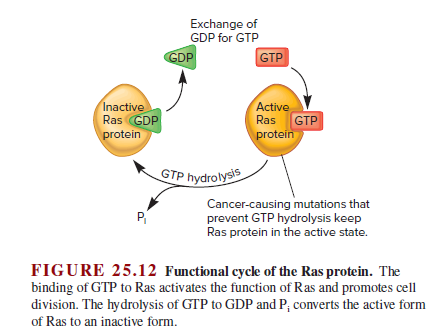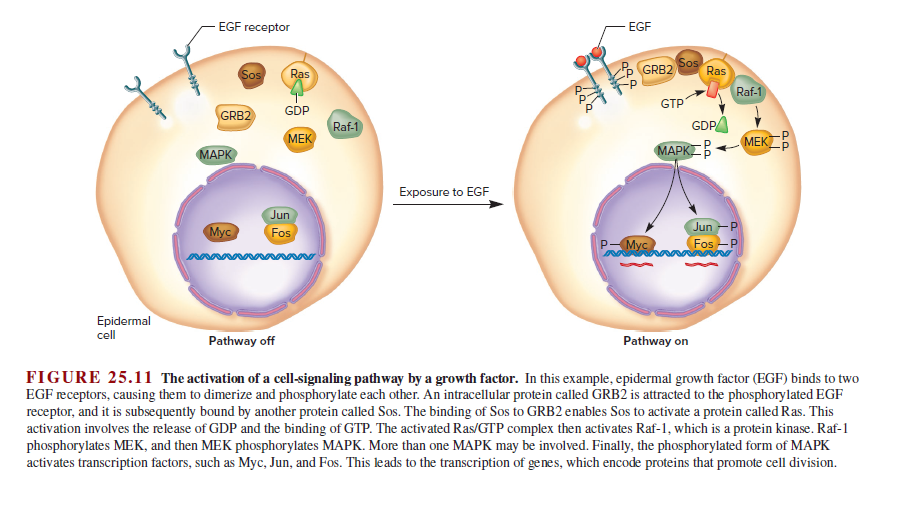Exchange of GDP for GTP GDP GTP Inactive Ras GDP protein Active Ras GTP protein GTP hydrolysts Cancer-causing mutations that prevent GTP hydrolysis keep Ras protein in the active state. FIGURE 25.12 Functional cycke of the Ras protein. The binding of GTP to Ras activates the function of Ras and promotes cell division. The hydrolysis of GTP to GDP and P; converts the active form of Ras to an inactive form. EGF receptor EGF Sos Ras Sos GRB2 Ras Raf-1 GDP GTP GRB2 Raf-1 GDP MEK MEK MAPK MAPKB Exposure to EGF Jun Jun -P Myc Fos Myc Fos -P Epidermal cell Pathway off Pathway on FIGURE 25.11 The activation of a cell-signaling pathway by a growth factor. In this example, epidermal growth factor (EGF) binds to two EGF receptors, causing them to dimerize and phosphorylate each other. An intracellular protein called GRB2 is attracted to the phosphorylated EGF receptor, and it is subsequently bound by another protein called Sos. The binding of Sos to GRB2 enables Sos to activate a protein called Ras. This activation involves the release of GDP and the binding of GTP. The activated Ras/GTP complex then activates Raf-1, which is a protein kinase. Raf-1 phosphorylates MEK, and then MEK phosphorylates MAPK. More than one MAPK may be involved. Finally, the phosphorylated form of MAPK activates transcription factors, such as Myc, Jun, and Fos. This leads to the transcription of genes, which encode proteins that promote cell division.
Exchange of GDP for GTP GDP GTP Inactive Ras GDP protein Active Ras GTP protein GTP hydrolysts Cancer-causing mutations that prevent GTP hydrolysis keep Ras protein in the active state. FIGURE 25.12 Functional cycke of the Ras protein. The binding of GTP to Ras activates the function of Ras and promotes cell division. The hydrolysis of GTP to GDP and P; converts the active form of Ras to an inactive form. EGF receptor EGF Sos Ras Sos GRB2 Ras Raf-1 GDP GTP GRB2 Raf-1 GDP MEK MEK MAPK MAPKB Exposure to EGF Jun Jun -P Myc Fos Myc Fos -P Epidermal cell Pathway off Pathway on FIGURE 25.11 The activation of a cell-signaling pathway by a growth factor. In this example, epidermal growth factor (EGF) binds to two EGF receptors, causing them to dimerize and phosphorylate each other. An intracellular protein called GRB2 is attracted to the phosphorylated EGF receptor, and it is subsequently bound by another protein called Sos. The binding of Sos to GRB2 enables Sos to activate a protein called Ras. This activation involves the release of GDP and the binding of GTP. The activated Ras/GTP complex then activates Raf-1, which is a protein kinase. Raf-1 phosphorylates MEK, and then MEK phosphorylates MAPK. More than one MAPK may be involved. Finally, the phosphorylated form of MAPK activates transcription factors, such as Myc, Jun, and Fos. This leads to the transcription of genes, which encode proteins that promote cell division.
Biochemistry
6th Edition
ISBN:9781305577206
Author:Reginald H. Garrett, Charles M. Grisham
Publisher:Reginald H. Garrett, Charles M. Grisham
Chapter30: Protein Synthesis
Section: Chapter Questions
Problem 15P
Related questions
Question
How would a mutation that prevents the Ras protein
from hydrolyzing GTP affect the cell-signaling pathway in 25.11?

Transcribed Image Text:Exchange of
GDP for GTP
GDP
GTP
Inactive
Ras GDP
protein
Active
Ras GTP
protein
GTP hydrolysts
Cancer-causing mutations that
prevent GTP hydrolysis keep
Ras protein in the active state.
FIGURE 25.12 Functional cycke of the Ras protein. The
binding of GTP to Ras activates the function of Ras and promotes cell
division. The hydrolysis of GTP to GDP and P; converts the active form
of Ras to an inactive form.

Transcribed Image Text:EGF receptor
EGF
Sos
Ras
Sos
GRB2
Ras
Raf-1
GDP
GTP
GRB2
Raf-1
GDP
MEK
MEK
MAPK
MAPKB
Exposure to EGF
Jun
Jun -P
Myc
Fos
Myc
Fos -P
Epidermal
cell
Pathway off
Pathway on
FIGURE 25.11 The activation of a cell-signaling pathway by a growth factor. In this example, epidermal growth factor (EGF) binds to two
EGF receptors, causing them to dimerize and phosphorylate each other. An intracellular protein called GRB2 is attracted to the phosphorylated EGF
receptor, and it is subsequently bound by another protein called Sos. The binding of Sos to GRB2 enables Sos to activate a protein called Ras. This
activation involves the release of GDP and the binding of GTP. The activated Ras/GTP complex then activates Raf-1, which is a protein kinase. Raf-1
phosphorylates MEK, and then MEK phosphorylates MAPK. More than one MAPK may be involved. Finally, the phosphorylated form of MAPK
activates transcription factors, such as Myc, Jun, and Fos. This leads to the transcription of genes, which encode proteins that promote cell division.
Expert Solution
This question has been solved!
Explore an expertly crafted, step-by-step solution for a thorough understanding of key concepts.
This is a popular solution!
Trending now
This is a popular solution!
Step by step
Solved in 2 steps

Knowledge Booster
Learn more about
Need a deep-dive on the concept behind this application? Look no further. Learn more about this topic, biochemistry and related others by exploring similar questions and additional content below.Recommended textbooks for you

Biochemistry
Biochemistry
ISBN:
9781305577206
Author:
Reginald H. Garrett, Charles M. Grisham
Publisher:
Cengage Learning

Biochemistry
Biochemistry
ISBN:
9781305577206
Author:
Reginald H. Garrett, Charles M. Grisham
Publisher:
Cengage Learning